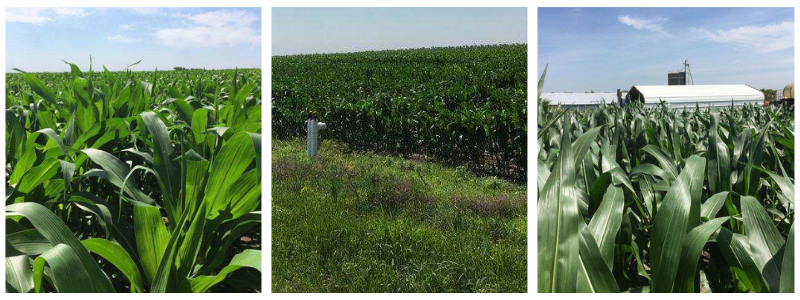From the Field
Efficient and Effective: Sub-Surface Drip Irrigation

The Flickner family; (left to right) Kelsey (daughter), Susan, Ray and Ryan (son.)
Blog post by Deb Ohlde, Central Kansas Corn Crew Rep.
Merriam-Webster defines irrigation as “the watering of land by artificial means to foster plant growth” There are any number of ways to do that; Ray Flickner of Wichita is in his 18th growing season with Sub-Surface Drip Irrigation (SDI).
The premise is the same as drip irrigation in gardens, except that the tape is buried. There is a water emitter every two feet and tape is spaced approximately every five feet across the field at a depth of 16 to 18 inches. Width of placement varies based on soil characteristics. For instance, in sandy soil tape is placed closer together. Water moves through the system from a pressure line on one end to a flush line on the other. The result is timed and strategic water infiltration, close to where the plant needs it with very little water loss.
SDI was very new when Flickner installed his first field. “The tape came on a roll and was wound the opposite direction from what the contractor expected. Unfortunately, that meant some of the tape in that first patch was installed upside down. That has been our only real challenge.” Flickner is fortunate to have good quality water. Without that, the upside-down tape might pose a bigger issue because keeping emitters clear of debris is key. Lime/hard water tends to plug emitters over time and rodents can also be a problem as they can chew right through the tape.
Flickner now has SDI on a total of 550 acres, for a very straightforward reason. “I don’t have fields that “fit” the pivot model. We have several smaller, odd shaped fields with obstructions. Without this it would have to be dry land because flood irrigation isn’t an option. With an off-farm job, moving pipe morning and night wasn’t feasible.” He also values the water efficiency of SDI which he pegs at 30 percent savings as well as the management options such as watering every acre a little bit every day and spoon-feeding nutrients at different growth stages.
There were some unanticipated aspects, as well, “Since water is being delivered at a deeper level, in a dry period your top 6 to 8 inches of soil can be very dry. But when it rains that means it really soaks in so you maximize rain fall. There is also less weed pressure since you aren’t watering the surface. After the first installation I also realized you can’t water the crop up the way you can with a pivot.”
The upfront cost of SDI is “like buying the farm all over again”, according to Flickner, but the water savings as well as the low daily maintenance make it worth it. “Corn farmers want to protect the water supply by minimizing use and run off. This system does just that.”
Other irrigation innovations that Flickner has tried include converting a pivot to a mobile drip. “You will see this more in Western Kansas. Innovations in water use are common there”, according to Flickner who is doing his part in South Central Kansas. He gathers data, is working with an engineer to crunch numbers and compare various approaches to irrigation across varying soil types. Research is challenging, as Flickner noted, “many variables impact yield and revenue; soil heath, heat units, water, and tillage options are a few. Soring it out is complex.” The goal is to maximize margin by balancing cost per acre with yield and per bushel price. That applies in both the short and long term.
Flickner’s wife Susan summed it up best, “Ray has an interest in making things better and being a good steward. He also likes the creative aspect of trying to figure out what will work and how it could be better. He has a passion for leaving things better than he found them.” That is the sweet spot where something efficient and effective becomes commendable.

